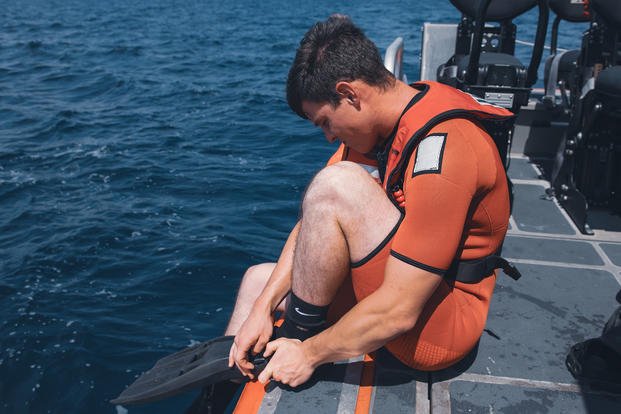If you have been motivated by the heroics played live on your television set or movie screens to think about becoming a Coast Guard Rescue Swimmer, be prepared. When you arrive at the Coast Guard Rescue Swimmer School in Elizabeth City, N.C., you will be expected to excel in one of the most stressful environments in military training.
According to the course syllabus, rescue swimmers must have flexibility, strength, endurance and be able to function for 30 minutes in heavy seas. So being comfortable in the water is an understatement. You have to be able to think and perform challenging tasks while submerged, holding your breath and getting tossed around my 10- to 20-foot waves.
Rescue swimmers also must have the skills to provide basic pre-hospital life support for rescued individuals. And as part of their training, candidates must complete an emergency medical training (EMT) course. This is not an ordinary EMT. They are exposed to high seas, rough terrain and other dangers an ordinary EMT will not survive.
The training you are seeking is hardcore physical and mental training that will challenge you to your core. In fact, Rescue Swimmer School boasts more than a 50% attrition rate, so it is crucial for you to score high on your physical fitness test (PFT) but, more importantly, be confident in the water.
Not cocky. You must have a deep respect for the power of the sea, but know that your training will help save your life and the lives of others.
The required monthly physical training test includes push-ups, sit-ups, pull-ups, chin-ups, a 12-minute crawl swim (500-yard minimum), a 25-yard underwater swim and a 200-yard buddy tow.
Rescue swimmer minimum PFT standards:
|
Exercise |
Minimum Standard |
|
Shoulder-width push-ups |
50 |
|
Sit-ups |
60 |
|
Pull-ups |
5 |
|
Chin-ups |
5 |
|
500-yard crawl swim |
Completed within 12 minutes |
|
25-yard underwater swim |
Repeat four times |
|
Buddy tow |
200 yards (Rescue swimmers shall use the cross-chest carry or equipment tow.) |
I recommend the following scores to succeed better with the training course:
-
Push-ups 100 in 2:00
-
Sit-ups 100 in 2:00
-
Pull-ups 15-20
-
12:00 swim (swim 500-750 yards)
-
1.5-mile run (sub-nine minutes)
-
25-yard underwater swim (complete)
-
200-yard buddy tow (complete)
If you are considering this profession, take an ocean lifeguard course with the Red Cross to see whether you have what it takes. You will learn how to perform the crawl stroke, underwater swim and buddy tow properly with this preparatory lifeguard course.
More USCG special training articles:
More swimming articles:
PT programs to train for the Coast Guard PFT can be found at the following Military.com links:
Other related Coast Guard fitness articles:
Stew Smith is a former Navy SEAL and fitness author certified as a Strength and Conditioning Specialist (CSCS) with the National Strength and Conditioning Association. Visit his Fitness eBook store if you're looking to start a workout program to create a healthy lifestyle. Send your fitness questions to stew@stewsmith.com.
Want to Learn More About Military Life?
Whether you're thinking of joining the military, looking for fitness and basic training tips, or keeping up with military life and benefits, Military.com has you covered. Subscribe to Military.com to have military news, updates and resources delivered directly to your inbox.


















